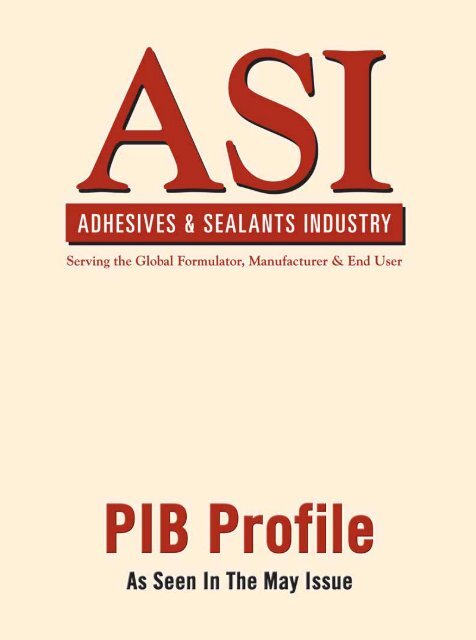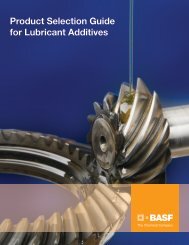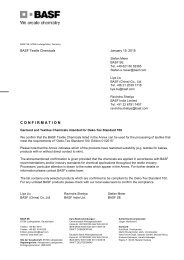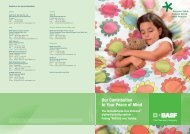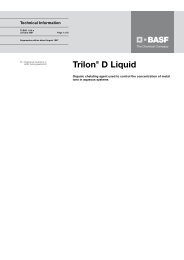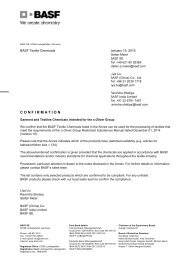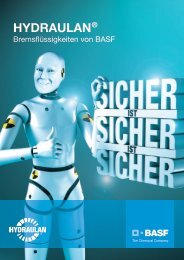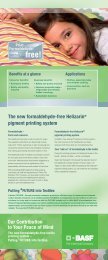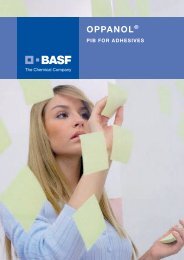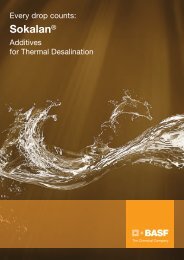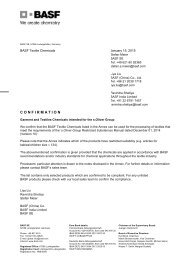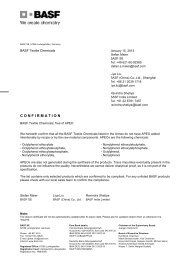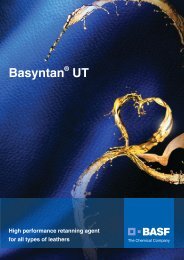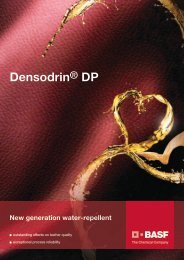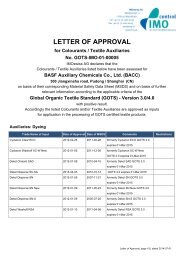PIBs - the Performance Chemicals division - BASF.com
PIBs - the Performance Chemicals division - BASF.com
PIBs - the Performance Chemicals division - BASF.com
Create successful ePaper yourself
Turn your PDF publications into a flip-book with our unique Google optimized e-Paper software.
JUST<br />
Add<br />
<strong>PIBs</strong><br />
Polyisobutylenes are a vital part of adhesive and sealant formulations<br />
By Dr. Timea Marsalko, Business Manager, PIB and Derivatives, <strong>BASF</strong> Corp., Florham Park, NJ; and<br />
Dr. Margit Hiller, Technical Marketing Manager, PIB and Derivatives, <strong>BASF</strong> AG, Ludwigshafen, Germany.<br />
<strong>BASF</strong> has a long history of producing<br />
materials for improving<br />
adhesives and sealants formulations.<br />
<strong>BASF</strong> acrylates, for instance,<br />
have been widely used in <strong>the</strong> industry.<br />
This article focuses on <strong>the</strong> <strong>com</strong>pany’s<br />
contributions through <strong>the</strong> growing<br />
presence of polyisobutylenes (<strong>PIBs</strong>) in<br />
adhesives and sealants.<br />
<strong>PIBs</strong> are not new. <strong>BASF</strong> invented <strong>the</strong><br />
materials and has marketed a range of<br />
polyisobutylenes since <strong>the</strong> late 1930s.<br />
Since <strong>the</strong>n, additional molecular weights<br />
and performance characteristics have<br />
been added to offer new options and new<br />
applications to formulators. The current<br />
portfolio of PIB products includes<br />
low-molecular-weight (trade named<br />
Glissopal), medium-molecular-weight<br />
(trade named Oppanol B 10 SFN –<br />
Oppanol B 15 SFN) and high-molecular-weight<br />
grades (trade named<br />
Oppanol B 30 SF – Oppanol B 200).<br />
Polyisobutylenes are aliphatic polymers<br />
and are widely used in solventbased<br />
or melt-based formulations.<br />
They are an excellent choice of raw<br />
materials for applications that are<br />
moisture sensitive or must be water<br />
insoluble. Depending on <strong>the</strong> application,<br />
different molecular weight grades<br />
or <strong>com</strong>binations of several PIB grades<br />
or <strong>com</strong>binations of PIB and butyl rubber<br />
are used to achieve <strong>the</strong> properties<br />
of <strong>the</strong> final products. Generally, lowmolecular-weight<br />
products are used as<br />
tackifiers and/or plasticizers, whereas<br />
medium- and high-molecular-weight<br />
products are used to adjust properties<br />
such as flexibility, elongation, cohesive<br />
strength, and gas barrier performance.<br />
With <strong>the</strong> correct choice and ratio of<br />
PIB(s), formulators can tailor peel and<br />
tack as well as extend <strong>the</strong> lifetime of<br />
<strong>the</strong> finished goods.<br />
Figure 1. <strong>BASF</strong> PIB Grades<br />
Several different systems are used to<br />
<strong>com</strong>pound adhesives and sealants<br />
using solvent or melt technology.<br />
Polyisobutylenes are often used in noncurable<br />
applications, and in several<br />
cases <strong>the</strong>y can be interchanged with<br />
(replacing) or performance-enhancing<br />
butyl rubber <strong>com</strong>ponents in butyl systems.<br />
These butyl systems contain polyisobutylene<br />
(<strong>com</strong>pletely saturated polymer),<br />
butyl rubber (double bonds in <strong>the</strong><br />
molecular chains), or a <strong>com</strong>bination of<br />
both. Butyl rubber is favorable when it<br />
<strong>com</strong>es to cohesive strength and creep<br />
resistance, whereas polyisobutylene<br />
Reprinted with permission from Adhesives & Sealants Industry magazine, BNP Media
Pressure-sensitive and removable tapes are usually<br />
formulated with <strong>the</strong> use of one or two different molecular<br />
weight <strong>PIBs</strong> and butyl or chlorobutyl rubber.<br />
Polyisobutylenes are used to seal joints, to seal<br />
and protect electrical wiring, and to protect<br />
body cavities from moisture.<br />
offers good flexibility, tack, and peel<br />
strength. To adjust <strong>the</strong> properties of a<br />
formulation to <strong>the</strong> required end use,<br />
<strong>com</strong>binations of both polymer types are<br />
often used.<br />
Although <strong>PIBs</strong> do not have more than<br />
one double bond per polymer chain, <strong>the</strong>y<br />
are considered to be non-crosslinkable<br />
products by conventional crosslinking<br />
chemistry (sulphur or peroxide cure).<br />
There are, however, several special<br />
crosslinking modes in which <strong>PIBs</strong> could<br />
be<strong>com</strong>e crosslinkable, such as via radiation<br />
curing.<br />
Polyisobutylenes have better aging<br />
characteristics than rubber-based (especially<br />
natural rubber-based) systems. PIBbased<br />
products remain permanently<br />
tacky and are used on surfaces o<strong>the</strong>r<br />
polymers do not adhere to.<br />
TYPICAL APPLICATIONS<br />
The window sealant industry in Europe,<br />
governed by higher energy standards, is<br />
dominated by double-glazing window<br />
sealants. PIB is <strong>the</strong> base polymer and <strong>the</strong><br />
main <strong>com</strong>ponent in <strong>the</strong>se formulations.<br />
In <strong>the</strong>se sealant systems, mainly Oppanol<br />
B 15 or mixtures of Oppanol B 15 and<br />
Oppanol B 10 are formulated. Oppanol is<br />
primarily used because it has excellent<br />
barrier properties and excellent flexibility,<br />
even at low temperatures.<br />
Fur<strong>the</strong>rmore, it is able to seal hermetically,<br />
due to its tackiness and cold flow,<br />
to even rough glass surfaces.<br />
New systems emerging on <strong>the</strong> market<br />
called TPS ® (<strong>the</strong>rmoplastic spacer) systems<br />
contain PIB. Butyl tape sealants<br />
contain a mixture of high- and mediummolecular-weight<br />
<strong>PIBs</strong> to achieve <strong>the</strong><br />
Table. PIB Property Profile for Outstanding Product Features<br />
(Property profile is unique in <strong>the</strong> segments of adhesives and sealants)F<br />
• Excellent barrier to moisture and gas<br />
• Elasticity over a wide temperature range – even at low temperatures<br />
• Permanent tackiness<br />
• Excellent aging characteristics<br />
• Cold flow for self healing materials and hermetic sealing of rough surfaces<br />
• High up-take of fillers<br />
• Odorless and colorless for superior aes<strong>the</strong>tics<br />
• PIB is a non-curable polymer - except by radiation curing - and certain grades<br />
of <strong>the</strong> MW range are very viscous and have high damping properties.<br />
right <strong>com</strong>bination of strength and tackiness.<br />
In general, butyl-based sealants are<br />
processed as pliable-tape or as a hot-melt<br />
system. They can be used in joints with<br />
movement of up to 10-15%.<br />
PIB-based sealants are also used in<br />
several non-window applications.<br />
Commercial pipes in underground or<br />
underwater locations can be protected<br />
against <strong>the</strong> corrosive nature of <strong>the</strong><br />
environment. Those pipes are wrapped<br />
with adhesives tapes that usually contain<br />
polyisobutylenes.<br />
Underwater cables are filled with PIB<br />
for two main reasons: to provide selfhealing<br />
properties and to <strong>com</strong>bat potential<br />
punctures, and to keep moisture<br />
away from <strong>the</strong> optical fibers.<br />
Higher molecular weight polyisobutylenes<br />
are also used in roofing<br />
membranes. One notable application is a<br />
technology imported from Europe. These<br />
roofing membranes are primarily used in<br />
<strong>com</strong>mercial roofing and protect <strong>the</strong><br />
structures from rain and melting snow by<br />
providing moisture sealing.<br />
From manufacturing to transports to <strong>the</strong><br />
dealer, today's automobiles are protected by<br />
using a <strong>com</strong>posite polymer layer containing<br />
<strong>PIBs</strong>. In a variety of important automotive<br />
sealant applications, polyisobutylenes are<br />
used to seal joints, to seal and protect electrical<br />
wiring, and to protect body cavities<br />
from moisture.<br />
The seals in food cans and jars could<br />
contain <strong>PIBs</strong>, which provide an excellent<br />
Reprinted with permission from Adhesives & Sealants Industry magazine, BNP Media
JUST ADD PIBS<br />
gas and moisture barrier. They are inert<br />
and clean, fulfilling a variety of FDA<br />
food contact requirements.<br />
Adhesives generally cover a large variety<br />
of chemistry and technology bases.<br />
Polyisobutylenes are used in many<br />
adhesive formulations due to <strong>the</strong>ir tackiness,<br />
flexibility and low cohesive<br />
strength. PIB is used in adhesive systems<br />
— mainly pressure-sensitive and hotmelt<br />
adhesives.<br />
Pressure-sensitive and removable tapes<br />
are usually formulated with <strong>the</strong> use of one or<br />
two different molecular weight <strong>PIBs</strong> and<br />
butyl or chlorobutyl rubber. Medium-molecular-weight<br />
<strong>PIBs</strong> are great for adhering to<br />
<strong>the</strong> surface. The high-molecular-weight version<br />
is preferred when <strong>the</strong> finished article is<br />
die cut or when <strong>the</strong> formulation is extruded<br />
during processing.<br />
<strong>PIBs</strong> are not a skin irritant and <strong>BASF</strong><br />
<strong>PIBs</strong> have a very low level of impurities.<br />
Therefore, PIB-based adhesives that<br />
require human contact, such as woundcare<br />
products or ostomy devices, are usually<br />
based on <strong>PIBs</strong>.<br />
For more information on polyisobutylenes, visit<br />
www.basf.<strong>com</strong>/pib_derivatives.<br />
PIB is used in adhesive systems — mainly<br />
pressure-sensitive and hot-melt<br />
adhesives.<br />
INFORMATION<br />
General Information:<br />
www.basf.<strong>com</strong>/pib_derivatives<br />
oppanol@basf.<strong>com</strong><br />
Business Management Europe:<br />
Dr. Erwin Czech<br />
+49-621-60-71180 or<br />
erwin.czech@basf-ag.de<br />
<strong>BASF</strong> AG<br />
Unit: EVO/EP<br />
Building J550<br />
Carl-Bosch-Strasse 38<br />
D-67056 Ludwigshafen<br />
Germany<br />
Business Management NAFTA:<br />
Dr. Timea Marsalko<br />
+1-973-245-6175 or marsalt@basf.<strong>com</strong><br />
<strong>BASF</strong> Corporation<br />
Unit: N-EVO/N<br />
100 Campus Drive<br />
Florham Park, NJ 07932<br />
USA<br />
Business Management Asia:<br />
Mr. Michael-e Hu<br />
+65-6432-3405 or<br />
huem@basf-sea.<strong>com</strong>.sg<br />
<strong>BASF</strong> South East Asia<br />
Unit: A-EVO/A<br />
7 Temasek Boulevard<br />
35-01 Suntec Tower One<br />
038987 Singapore<br />
Singapore<br />
Business Management South America:<br />
Ms. Gisele Regina Dos Santos<br />
+55-11-4343-3119 or<br />
gisele.santos@basf-sa.<strong>com</strong>.br<br />
<strong>BASF</strong> SA<br />
Unit: S-EV/SD<br />
Building C<br />
Estrada Samuel Aizemberg 1707<br />
09851550 <strong>BASF</strong> - Imigrantes<br />
Brazil, Region SP<br />
Business Management East Europe, Africa,<br />
Middle East, etc.:<br />
Mr. Gerhard Leidig<br />
+49-621-60-76552 or<br />
gerhard.leidig@basf-ag.de<br />
<strong>BASF</strong> AG<br />
Unit: EUM/SE<br />
Building: LU-Benckiserplatz<br />
Benckiserplatz 1<br />
D-67056 Ludwigshafen<br />
Germany<br />
Technical & Strategic Marketing (Adhesives<br />
& Sealants):<br />
Dr. Margit Hiller<br />
+49-621-60-47498 or<br />
margit.hiller@basf-ag.de<br />
<strong>BASF</strong> AG<br />
Unit: G-EVO/MP<br />
Building: J 550<br />
Carl-Bosch-Strasse 38<br />
D-67056 Ludwigshafen<br />
Germany<br />
Reprinted with permission from Adhesives & Sealants Industry magazine, BNP Media


